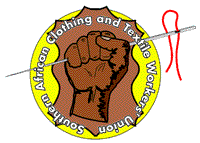Related Research Articles

The World Federation of Trade Unions (WFTU) is an international federation of trade unions established in 1945. Founded in the immediate aftermath of World War Two, the organization built on the pre-war legacy of the International Federation of Trade Unions as a single structure for trade unions world-wide, following the World Trade Union Conference in London, United Kingdom.

The International Textile, Garment and Leather Workers' Federation (ITGLWF) was a global union federation. In 2005 it had 217 member organizations in 110 countries, representing a combined membership of over 10 million workers.

The Southern African Clothing and Textile Workers' Union (SACTWU) is the biggest union in the South African clothing, textile, footwear and leather industry, with more than 100 000 members. It negotiates wages for the vast majority of workers in these industries in South Africa, with the collective bargaining agreements covering over 150 000 workers.
Community is a British trade union which formed in 2004. The union represents workers in a diverse range of sectors, including iron and steel, justice and custodial, domestic appliance manufacturing, textiles and footwear, road transport, betting, the third sector, education and early years as well as the self-employed.
The Australian Textile Workers' Union (ATWU) was an Australian trade union which existed from 1919 to 1987. The ATWU represented Australian workers employed in the manufacture of textiles, including the spinning, weaving, dyeing and finishing of all types of fibres. Later, the union also represented workers employed in manufacturing felt hatting.
The United Hatters, Cap and Millinery Workers International Union (1934–1983), also known by acronyms including UHCMW, U.H.C. & M.W.I.U. and UHC & MWIU, was a 20th-century American labor union.
The Trade Union International of Textile, Leather and Fur Workers Unions was a trade union international affiliated with the World Federation of Trade Unions.
The General Union of Loom Overlookers (GULO) was a trade union representing junior supervisors in textile manufacturing in the United Kingdom. While most members were based in Lancashire, it also had members in Yorkshire, East Anglia and Essex.
The Textile and Clothing Union was a West German trade union representing textile and clothing workers.
Karl Buschmann was a German trade union leader.
Berthold Keller was a German trade union leader.
The Chemical Union was a trade union representing workers in light industries in Finland.
The Textile and Clothing Workers' Union was a trade union representing workers involved in making textiles in Finland.
The Federation of Hides, Leather, and Kindred Trades was a trade union representing workers in various related industries, including shoemaking, in France.
The Industrial Union of Textiles, Clothing and Leather was a trade union representing workers in the textile, clothing, leather, and tobacco industries in East Germany.
The Swedish Shoe and Leather Workers' Union was a trade union representing workers in the leather industry in Sweden.
The Swedish Clothing Workers' Union was a trade union representing workers in the garment industry in Sweden.
The Swedish Textile Workers' Union was a trade union representing workers in the textile industry in Sweden.
The Association of Trade Unions was a nominal national trade union federation in Poland.
The United Shoe Workers of America (USWA) was a trade union representing workers involved in making shoes and other leather goods.